 Malapolski
Malapolski
 Malapolski horse were developed in the 19th century in
Lesser Poland, Polish Malopolska, hence the name. They are a versatile breed,
used today for light draft and under-saddle work.
Malapolski horse were developed in the 19th century in
Lesser Poland, Polish Malopolska, hence the name. They are a versatile breed,
used today for light draft and under-saddle work.
They were developed from a combination of Arabian and Thoroughbred blood, with significant contributions from the Furioso and Gidrán breeds (both strains of Hungarian Anglo-Arabian. There are two distinct varieties of the Malapolski. The first is the Sadecki, which was heavily influenced by the Furioso line, and the second is the Darbowsko-Tarnowski, heavily influenced by theGidrá and Shagya Arab Gidrán line. They were also influenced by infusions of various other Arabian and Thoroughbred half-breeds. Today, they are breed at five ...

 Mallorquin
Mallorquin
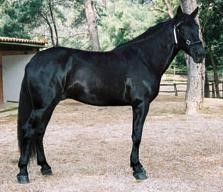 Mallorquins, or Caballo Mallorquins, are a rare breed of
horse indigenous to the island of Majorca in the Balearic Islands, from which
it takes its name. They were first identified in 1985 by the Patronato para las
Razas Autoctonas de Mallorca (''authority for the autochthonous breeds of
Mallorca''). Mallorquin horses are listed in the Catalogo Oficial de Razas de
Ganado de Espana in the group of autochthonous breeds in danger of extinction. Their
status was listed in 2007 as critical by the Food and Agriculture Organization
of the United Nations. In 2005 the number of Mallorquin horses recorded in the
stud book was 247, but a census conducted by the Ministerio de Medio Ambiente y
Medio Rural y Marino in 2003 identified only 172. I
...
Mallorquins, or Caballo Mallorquins, are a rare breed of
horse indigenous to the island of Majorca in the Balearic Islands, from which
it takes its name. They were first identified in 1985 by the Patronato para las
Razas Autoctonas de Mallorca (''authority for the autochthonous breeds of
Mallorca''). Mallorquin horses are listed in the Catalogo Oficial de Razas de
Ganado de Espana in the group of autochthonous breeds in danger of extinction. Their
status was listed in 2007 as critical by the Food and Agriculture Organization
of the United Nations. In 2005 the number of Mallorquin horses recorded in the
stud book was 247, but a census conducted by the Ministerio de Medio Ambiente y
Medio Rural y Marino in 2003 identified only 172. I
...

 Mangalarga
Mangalarga
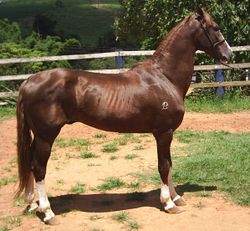 Mangalarga horses are from Brazil. They were first developed
by Francisco Gabriel Junqueira (Baron of Alfenas) who bred Royal Alter
stallions from Portugal with colonial horses in Brazil. This mix also
originated the Mangalarga Marchador breed that differs from Mangalarga horses
because Mangalarga Marchador’s have different, and unique, smooth gait.
Mangalarga horses are from Brazil. They were first developed
by Francisco Gabriel Junqueira (Baron of Alfenas) who bred Royal Alter
stallions from Portugal with colonial horses in Brazil. This mix also
originated the Mangalarga Marchador breed that differs from Mangalarga horses
because Mangalarga Marchador’s have different, and unique, smooth gait.
When the Junqueira family moved to Sao Paulo, the topography and local culture forced them to look for a horse with different characteristics and so they started to cross breed the Mangalarga with Hackney, Morgan, American Saddle, Hanoverian, and Trakehner horses. This made the Mangalarga a completely different horse breed form the Mangalarga Marchador. They are so diffe ...

 Mangalarga Marchador
Mangalarga Marchador
 Mangalarga Marchador comes from Brazil. They possess
Alter-Real blood lines that went on to be called Sublime Horses. They have a
very unique gait that appears to look somewhat like a march when they walk and
gallop. This gait is referred to as the marcha. In the eighteen hundreds the
Sublime horses began to be purchased by those called the Hacienda Mangalarga
group. It was at this point that they were no longer known as the Sublime
horses and changed to the Mangalarga Marchador style of horses. They are
notorious for their variances in marches including the marcha picada, the
marcha batida, and the center march. One is slower, one is a diagonal pace, and
the last one is thought to mimic the unique style of the Tennessee Walking
H
...
Mangalarga Marchador comes from Brazil. They possess
Alter-Real blood lines that went on to be called Sublime Horses. They have a
very unique gait that appears to look somewhat like a march when they walk and
gallop. This gait is referred to as the marcha. In the eighteen hundreds the
Sublime horses began to be purchased by those called the Hacienda Mangalarga
group. It was at this point that they were no longer known as the Sublime
horses and changed to the Mangalarga Marchador style of horses. They are
notorious for their variances in marches including the marcha picada, the
marcha batida, and the center march. One is slower, one is a diagonal pace, and
the last one is thought to mimic the unique style of the Tennessee Walking
H
...

 Maremmano
Maremmano
.jpg) The Maremmano horse
originated in the Maremma region of Tuscany and Lazio at the time of the ancient
Etruscans. From then until the nineteenth century it kept its original characteristics:
squat, strong and skittish. Then, in about 1870, it began to be crossed with more
lightly-built and docile horses. In the year 1902, the stallion Fauno was born at
the Royal Stables at San Rossore, Versilia, in Tuscany. The result of a cross with
an English thoroughbred, he was the first of the so-called “new generation”. The
introduction of the English thoroughbred smoothed out some of the squat, rough characteristics
of the original Maremmano, while also increasing its height and its rugged temperament.
The Maremmano horse
originated in the Maremma region of Tuscany and Lazio at the time of the ancient
Etruscans. From then until the nineteenth century it kept its original characteristics:
squat, strong and skittish. Then, in about 1870, it began to be crossed with more
lightly-built and docile horses. In the year 1902, the stallion Fauno was born at
the Royal Stables at San Rossore, Versilia, in Tuscany. The result of a cross with
an English thoroughbred, he was the first of the so-called “new generation”. The
introduction of the English thoroughbred smoothed out some of the squat, rough characteristics
of the original Maremmano, while also increasing its height and its rugged temperament.This is a strong, good-tempere ...

 Marwari
Marwari
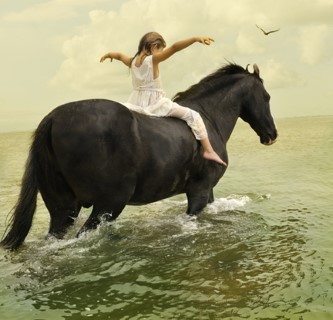 Marwari horses comes from the Northwestern areas of India.
They are notably brave and can be extremely loyal to their masters. They have
quite a reputation for being warriors, ones that refuse to leave a conflictive
situation if asked to. In fact, these creatures have been known to only leave a
battle area if they won the fight or had to carry away their injured solider.
This all further explains their ways and the methods in which they operate
solely on the adoration of their owners. Also widely popular in the area of
Rajasthan, this breed is said to have some form of Arabian bloodlines in them
as well. It comes as no surprise to their many followers as they are notably
striking in appearance, as well as stature. Only royal family
...
Marwari horses comes from the Northwestern areas of India.
They are notably brave and can be extremely loyal to their masters. They have
quite a reputation for being warriors, ones that refuse to leave a conflictive
situation if asked to. In fact, these creatures have been known to only leave a
battle area if they won the fight or had to carry away their injured solider.
This all further explains their ways and the methods in which they operate
solely on the adoration of their owners. Also widely popular in the area of
Rajasthan, this breed is said to have some form of Arabian bloodlines in them
as well. It comes as no surprise to their many followers as they are notably
striking in appearance, as well as stature. Only royal family
...

 Masuren
Masuren
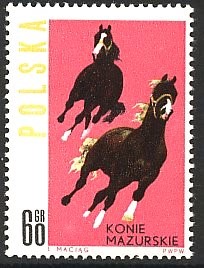 Masuren, or Mazury, horses are an extinct breed of horse
from Poland. They were once a very notable breed and was a quality riding
horse. Mainly they were developed from Trakehner horses, and crossed with Pozan
horses. Masuren horses were bred at the stud at Liski in the Masuria region. In
1963 a Polish postage stamp showing a Masuren horse was issued.
Masuren, or Mazury, horses are an extinct breed of horse
from Poland. They were once a very notable breed and was a quality riding
horse. Mainly they were developed from Trakehner horses, and crossed with Pozan
horses. Masuren horses were bred at the stud at Liski in the Masuria region. In
1963 a Polish postage stamp showing a Masuren horse was issued.

 Mecklenburger
Mecklenburger
 Mecklenburgers are warmblood horses from the
Mecklenburg-Vorpommern region of north-eastern Germany. They have been closely
linked to the State Stud of Redefin. Historically influenced by Arabian and
Thoroughbred blood, today''s Mecklenburger is an athletic riding and driving
horse similar to the neighboring Hanoverian. They are bred to the same
standards as the other German Warmbloods, and are especially suitable for
dressage and show jumping, though they are used for combined driving, eventing
and show hunter competition as well.
Mecklenburgers are warmblood horses from the
Mecklenburg-Vorpommern region of north-eastern Germany. They have been closely
linked to the State Stud of Redefin. Historically influenced by Arabian and
Thoroughbred blood, today''s Mecklenburger is an athletic riding and driving
horse similar to the neighboring Hanoverian. They are bred to the same
standards as the other German Warmbloods, and are especially suitable for
dressage and show jumping, though they are used for combined driving, eventing
and show hunter competition as well.
The region today known as Mecklenburg-Vorpommern was, until 1934, composed of the duchies of Mecklenburg-Schwerin and Mecklenburg-Strelitz. However, the region was united by virtue of bei ...

 Megezh
Megezh
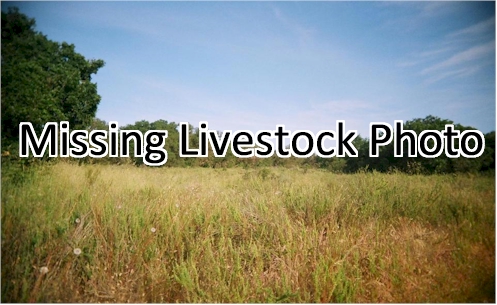 Very little is known about Megezh horses, other than that
they can be grullo, roan, grey, dun, sorrel, or bay, and that they are a
southern type of horse that has strains of Yakut, Olekminsk, and Suntar horse
breeds. Megezh is the largest type of the Yakut breed. They come from
southwestern Yakutia in the region of Leninsk.
Very little is known about Megezh horses, other than that
they can be grullo, roan, grey, dun, sorrel, or bay, and that they are a
southern type of horse that has strains of Yakut, Olekminsk, and Suntar horse
breeds. Megezh is the largest type of the Yakut breed. They come from
southwestern Yakutia in the region of Leninsk.
In the later part of the l9th century a tough horse with great endurance was needed for gold mining purposes. Thus Yakut and Kuznet breeds were crossed and the Megezh Horse emerged. The cross produced horse was strong and able to perform mining work. They are 14-15.1 hh. Other uses included milk and meat production.

 Menorquin
Menorquin
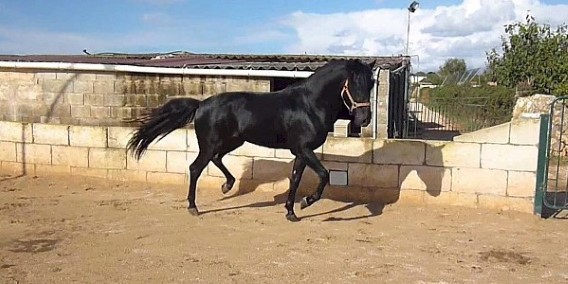 Menorquin Horses, or Cavall Menorqui, are indigenous to the
island of Menorca in the Balearic Islands, from which they get their name. They
are closely associated with the doma menorquina style of riding.
Menorquin Horses, or Cavall Menorqui, are indigenous to the
island of Menorca in the Balearic Islands, from which they get their name. They
are closely associated with the doma menorquina style of riding.
Menorca was under Moorish domination from 903–1287. According some sources, research has shown links between the Menorquín and Arab breeds, while others have shown it to be of Berber origin, and yet others believe that it was brought to Menorca from central Europe by King James I of Aragon. According to the Government of the Balearic Islands, it belongs to the eastern group of indigenous Iberian horses which also included the now extinct Catalan horse.
Menorquin horses were officially recognized ...

 Messara
Messara
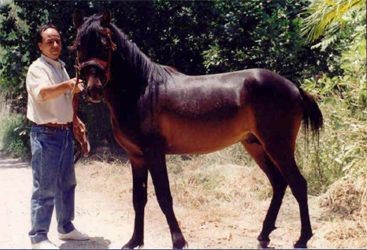 Messara (also known as Cretan) horses are a light riding and
draft horse found on the island of Crete off the coast of Greece.
Messara (also known as Cretan) horses are a light riding and
draft horse found on the island of Crete off the coast of Greece.
The native mountain-type Messara pony exists on the island of Crete since year 1000 or longer. The name comes from the Mesara Plain where they are mostly found. The modern Cretan horse was developed by crossing the native mares on Arabian stallions imported during the Turkish occupation in the 17th century. They are now a rare breed with around 100 representatives. Since 1994 there exists a studbook and conservation program has been started.
Their main coat colors are bay, brown (a variation of bay), black, and gray. They usually stand between 12.2 and 14 hands high. Most Mes ...

 Miniature
Miniature
 Miniature horses are, as expected, small…really small; usually
less than 34–38 inches (86–97 cm) as measured at the last hairs of the mane, which
are found at the withers. While miniature horses are the size of a very small pony,
many retain horse characteristics and are considered "horses" by their
respective registries. They have various colors and coat patterns.
Miniature horses are, as expected, small…really small; usually
less than 34–38 inches (86–97 cm) as measured at the last hairs of the mane, which
are found at the withers. While miniature horses are the size of a very small pony,
many retain horse characteristics and are considered "horses" by their
respective registries. They have various colors and coat patterns.
Miniature horses are friendly and interact well with people. For this reason they are often kept as family pets, though they still retain natural horse behavior, including a natural fight or flight instinct, and must be treated like an equine, even if they primarily serve as a companion animal. They are also trained as service animals, akin to assistance d ...

 Minusin
Minusin
 Minusin horses come from the Minusin Valley in the south
part of the Krasnodar region (Former Soviet Union) and was developed by the
people native to the area who have been breeding horses for hundreds of years.
As the needs for agriculture began to grow the breed was infused with the blood
of Don, Thoroughbred, and trotter stallions to provide it with needed size.
Minusin horses come from the Minusin Valley in the south
part of the Krasnodar region (Former Soviet Union) and was developed by the
people native to the area who have been breeding horses for hundreds of years.
As the needs for agriculture began to grow the breed was infused with the blood
of Don, Thoroughbred, and trotter stallions to provide it with needed size.They have a large head, Roman nose, thick neck, large trunk, and wide chest. Their legs are spindly but strong. They come in a variety of coat colors including bay, dun, grulla, palomino and buckskin.

 Misaki
Misaki
 Misaki Horses (Misaki uma in Japanese) are as tall of a pony,
yet they have many horse characteristics and proportions. The first reference
to Misaki Horses is in 1697, when the Akizuki family of the Takanabe Clan
rounded up feral horses and developed a pool of breeding stock. However,
following the end of World War II, Misaki horses were designated as a National
Natural Treasure and nowadays they have returned to feral life, mainly in a
designated National Monument on Cape Toi at the south end of the Miyazaki
Prefecture, attracting many tourists to the region.
Misaki Horses (Misaki uma in Japanese) are as tall of a pony,
yet they have many horse characteristics and proportions. The first reference
to Misaki Horses is in 1697, when the Akizuki family of the Takanabe Clan
rounded up feral horses and developed a pool of breeding stock. However,
following the end of World War II, Misaki horses were designated as a National
Natural Treasure and nowadays they have returned to feral life, mainly in a
designated National Monument on Cape Toi at the south end of the Miyazaki
Prefecture, attracting many tourists to the region. Missouri Fox-Trotter comes from Missouri, US (which you
could have guessed by the name). They have received their unique name from the
dance they did when they were developed in the Missouri Ozarks. They have a fluid
four beat gait. This makes for a very graceful ride. They are well known for
being easy to manipulate through mountainous terrains. Many years ago, it was
thought that the pioneers utilized these horses to get from the Mississippi
River to Tennessee, then also to Virginia. They were first called an Ozark Hill
Horse and were used frequently for many farmers. They were finally registered
in Ava, Missouri sometime during the middle of the nineteenth century.
Missouri Fox-Trotter comes from Missouri, US (which you
could have guessed by the name). They have received their unique name from the
dance they did when they were developed in the Missouri Ozarks. They have a fluid
four beat gait. This makes for a very graceful ride. They are well known for
being easy to manipulate through mountainous terrains. Many years ago, it was
thought that the pioneers utilized these horses to get from the Mississippi
River to Tennessee, then also to Virginia. They were first called an Ozark Hill
Horse and were used frequently for many farmers. They were finally registered
in Ava, Missouri sometime during the middle of the nineteenth century.
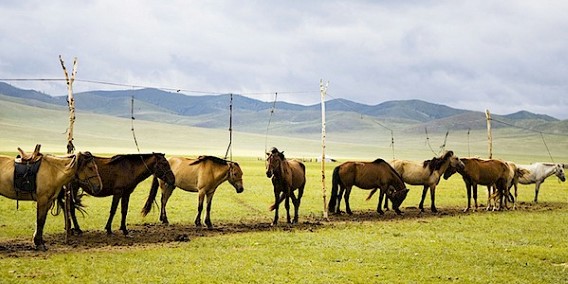 Mongolian horses (Mongolian aduu: "horse" or mori;
or as a herd, ado, or in Northern Khalka, tabun) are the native horse breed of
Mongolia. They are considered to be have been largely unchanged since the time
of Genghis Khan. Nomads living in the traditional Mongol fashion still hold
more than 3 million horses, which outnumber the country''s human population.
Despite their small size, they are horses, not ponies. In Mongolia, the horses
live outdoors all year, dealing with temperatures from 30 °C (86 °F) in summer
down to -40 °C (-40 °F) in winter, and they graze and search for food on their
own. The mare''s milk is processed into the national beverage airag. Some
animals are slaughtered for meat. Other than that, they serve as rid
...
Mongolian horses (Mongolian aduu: "horse" or mori;
or as a herd, ado, or in Northern Khalka, tabun) are the native horse breed of
Mongolia. They are considered to be have been largely unchanged since the time
of Genghis Khan. Nomads living in the traditional Mongol fashion still hold
more than 3 million horses, which outnumber the country''s human population.
Despite their small size, they are horses, not ponies. In Mongolia, the horses
live outdoors all year, dealing with temperatures from 30 °C (86 °F) in summer
down to -40 °C (-40 °F) in winter, and they graze and search for food on their
own. The mare''s milk is processed into the national beverage airag. Some
animals are slaughtered for meat. Other than that, they serve as rid
...
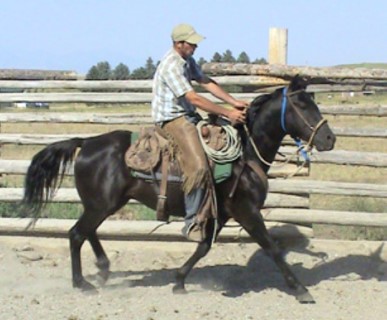 Montana Travler horses were developed in the US state of Montana
and are a relatively new saddle horse breed. In the 1930s, Montanan Tom Eaton
began combining the bloodlines of Tennessee Walking, Morgan, American
Saddlebred, Thoroughbred, and Hamiltonian horses in a search for "the
perfect horse." By the early 1970s, his breeding resulted in an
eye-catching, ground-covering chestnut stallion.
Montana Travler horses were developed in the US state of Montana
and are a relatively new saddle horse breed. In the 1930s, Montanan Tom Eaton
began combining the bloodlines of Tennessee Walking, Morgan, American
Saddlebred, Thoroughbred, and Hamiltonian horses in a search for "the
perfect horse." By the early 1970s, his breeding resulted in an
eye-catching, ground-covering chestnut stallion.
 Monterufoli Ponies originated in the
province of Pisa (Tuscany), particularly in the area of Monterufoli. According to
some writers it derived from a now extinct type known as the “Selvina Breed” which
lived in the wild. The area from where the Montrufoli comes is now largely covered
by the “Monterufoli-Caselli” Nature Reserve, a hilly region lying at between100
and 560 metres above sea level.
Monterufoli Ponies originated in the
province of Pisa (Tuscany), particularly in the area of Monterufoli. According to
some writers it derived from a now extinct type known as the “Selvina Breed” which
lived in the wild. The area from where the Montrufoli comes is now largely covered
by the “Monterufoli-Caselli” Nature Reserve, a hilly region lying at between100
and 560 metres above sea level.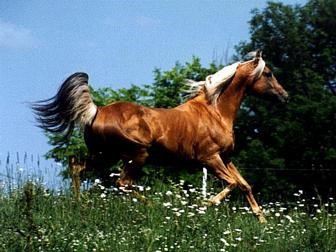 Morab horses were originally developed in the late 1880’s
through the cross-breeding of Arabian and Morgan horses. They were developed
with the intent of creating a fine carriage horse that was still substantial
enough for moderate farm labor. The modern Morab continues this tradition of
paired power and elegance, being both attractive and competitive show animals,
and strong but mild-mannered work and family horses.
Morab horses were originally developed in the late 1880’s
through the cross-breeding of Arabian and Morgan horses. They were developed
with the intent of creating a fine carriage horse that was still substantial
enough for moderate farm labor. The modern Morab continues this tradition of
paired power and elegance, being both attractive and competitive show animals,
and strong but mild-mannered work and family horses.
 Morgan horses were one of the first horse breeds developed in
the United States. All Morgans can trace their lineage back to a horse Justin Morgan,
who was named after his owner.
Morgan horses were one of the first horse breeds developed in
the United States. All Morgans can trace their lineage back to a horse Justin Morgan,
who was named after his owner. 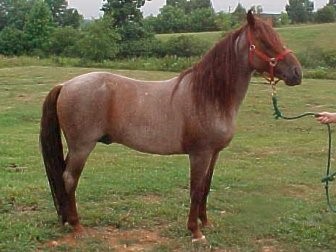 Mountain Pleasure horses have been relatively unchanged for
a century or more. They reflect the primitive Appalachian gaited horse type and
may be ancestral to modern breeds developed in the region during the late
1800''s and early 1900''s, including American Saddlebred and Tennessee Walking
Horses.
Mountain Pleasure horses have been relatively unchanged for
a century or more. They reflect the primitive Appalachian gaited horse type and
may be ancestral to modern breeds developed in the region during the late
1800''s and early 1900''s, including American Saddlebred and Tennessee Walking
Horses.
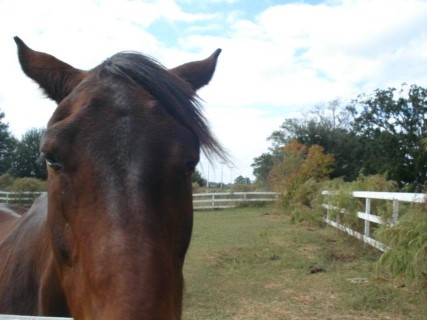 Moyle horses are famous for their frontal bosses, referred to
as horns, thought to be inherited from Asian ancestors. Moyle horses were
developed in Idaho by Rex Moyle from Mustangs brought from Utah. According to
some studies, it is said that the Moyle may have descended from the Spanish
Carthusian horses.
Moyle horses are famous for their frontal bosses, referred to
as horns, thought to be inherited from Asian ancestors. Moyle horses were
developed in Idaho by Rex Moyle from Mustangs brought from Utah. According to
some studies, it is said that the Moyle may have descended from the Spanish
Carthusian horses.
 This breed originates
from, and is spread throughout Puglia: in particular, the Murge region. It can trace
its origins to the time of Spanish domination, when Arab, Berber and Andalusian
stallions were brought in. But the real development of the Murgese horse was thanks
to the Counts of Conversano. They were a family of farsighted nobles who were very
adept in choosing horses for importation and careful in selecting those which fitted
the needs of the time and the character of the area. The breed was first officially
registered in 1926 at the “Deposito Stalloni” (Stallion Registry), which later became
the “Istituto di Incremento Ippico di Foggia” (Foggia Institute of Horse Breeding).
This breed originates
from, and is spread throughout Puglia: in particular, the Murge region. It can trace
its origins to the time of Spanish domination, when Arab, Berber and Andalusian
stallions were brought in. But the real development of the Murgese horse was thanks
to the Counts of Conversano. They were a family of farsighted nobles who were very
adept in choosing horses for importation and careful in selecting those which fitted
the needs of the time and the character of the area. The breed was first officially
registered in 1926 at the “Deposito Stalloni” (Stallion Registry), which later became
the “Istituto di Incremento Ippico di Foggia” (Foggia Institute of Horse Breeding). Mustang horses are descendants of Spanish, or Iberian,
horses that were brought to the Americas by Spanish explorers in the 16th
century. The name was derived from the Spanish word mustengo, which means
"ownerless beast" or "stray horse." These horses bred with
other breeds of horses, including quarter horses and draft horses, to create
the breed we know today.
Mustang horses are descendants of Spanish, or Iberian,
horses that were brought to the Americas by Spanish explorers in the 16th
century. The name was derived from the Spanish word mustengo, which means
"ownerless beast" or "stray horse." These horses bred with
other breeds of horses, including quarter horses and draft horses, to create
the breed we know today.